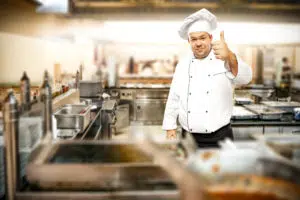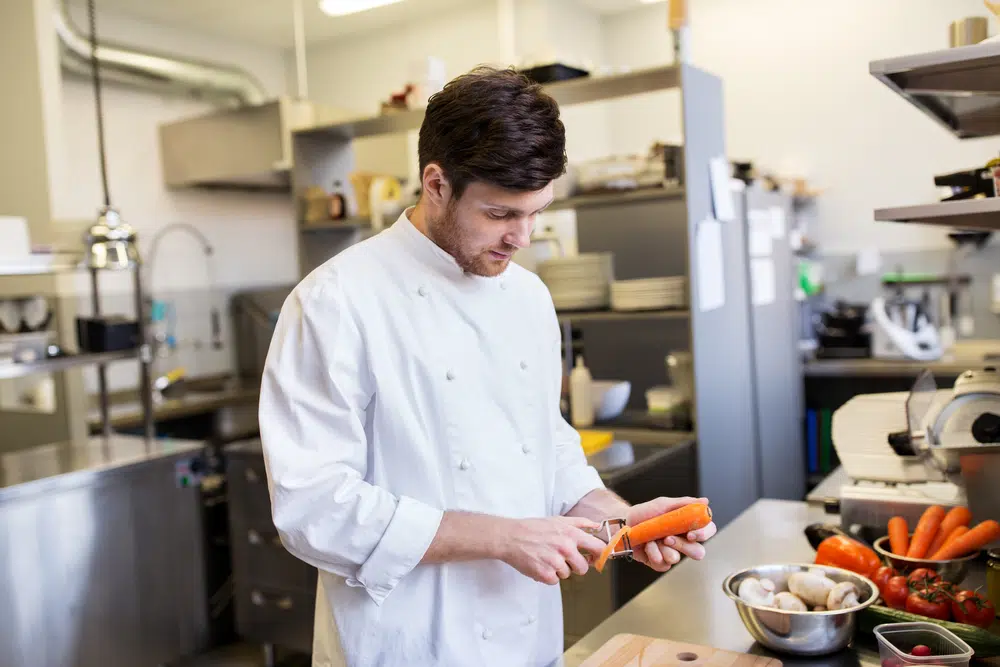
Although responsibility for a financial failure always lies with an owner; the machines we work with can make the difference between “light and airy” and “dank and disastrous” in any given kitchen.
If you want to give your staff the best chance at culinary success then there are certain pieces of kitchen equipment you just should not do without.
They have been designed to speed up production, cut down on time spent, and maximise your profits as a small to medium business owner.
Commercial Kitchen Equipment List
The size of your restaurant commercial kitchen and the restaurant concept, is dependent of the equipment you will need. You may need other types of equipment more specific to your restaurant concept, such as a commercial pasta press if your restaurant will make lots of pasta dishes, or perforated loaf tins if you plan to make your bread in-house.
Be sure you’re considering every aspect of your menu plan and kitchen layout as you make your professional kitchen equipment list.
The role of a restaurant kitchen
The kitchen area is the very soul of your restaurant and ultimately provides the main thing your customers are here for: the food. This is the place where your menu becomes a reality, and the talents of your chefs are showcased for all to see. It is also home to the vast majority of the equipment you’ll need for your business venture to function effectively.
The kitchen will likely act as a home to the dishwasher, the ingredients, the cooking equipment, dishes, pots and pans, and all other kinds of utensils. Not only will it store these things, but it will also keep them organised and tidy, making the daily working life of your staff much easier and far less stressful.
This area differs greatly from the kitchen you’d find in someone’s house however, as in a restaurant this area can have loads of people coming and going throughout the day as people work through their shifts. Therefore, it is so important to ensure it is well organised. Not only will this help you to make the busier times a whole lot easier, but it will also provide a safer working environment for your staff members.
What type of restaurant do you run?
Depending on the style of restaurant you own, you may require different pieces of equipment. For example, you may want to buy commercial kitchen equipment, but own a niche establishment such as a ghost kitchen. If you run a café, you will need items that suit the needs of one, whereas you will require fast food equipment if you are the owner of that sort of establishment.
The equipment for a restaurant is completely dependent on the category it falls under; this is something you should think about carefully before purchasing certain things and harming your overall budget. You will need funding for other areas too, such as buying ingredients, paying members of staff their wages, and repairing the restaurant in any way when it requires attention.
Contingent upon the size of your restaurant kitchen and its main concept, you may not require each thing we mention here. Or then again you might require different kinds of equipment more relevant and unique to your restaurant idea. Be certain you’re thinking about each part of your menu plan and kitchen design as you push forward with developing your own kitchen equipment checklist that is unique to your small business venture and that alone.
Through the use of our commercial kitchen equipment checklist, you should be able to identify the things that fit perfectly within your business and make the correct purchases from there. There is no need for you to waste money on excess materials that won’t actually be of any use to you, so do your research before paying a lot of money on something you’ll never need.
Commercial Kitchen Checklist
There are a few considerations you need to make. Your budget will disappear quickly so try to make money last. You should also think about specialisations. For example: a commercial ice cream parlour has no need for a pasta maker. Otherwise, follow this guide – and employ common sense – and you should end up with all the right parts to get cooking!
Interested? You should be! Here are the top 21 checklist of the most essential pieces of commercial kitchen equipment that your restaurant, café, or eatery needs to stay at the top of the game.
21 – Your Oven
Commercial kitchens don’t just need a standard oven. They specifically need a six burner (at least) gas oven with removable top plates. All of these will need to come apart and be washed at the end of each shift. Worse, a build-up of oven grease can physically set your kitchen alight. Don’t risk it and buy removable tops.
A good oven should have sliding drip trays and the capacity to hit 300 degrees. Go with gas because it cooks much faster and your chefs will expect it. Think about positioning as well. You will want your sweet section as far from your oven as possible.
20 – Oven Number 2
No joke. What if you are mid Saturday night service and your oven breaks. Are you going to send your customers home? No. That’s why most professional kitchens have two 6 burner stoves.
If you are newly starting one is enough to get you by. If you are established: two will stop you having to close for repairs. It’s your call. Your ovens will also need a filter, or some sort of extraction system, and these run up costs of thousands.
19 – How’s your flooring?
Your floors are actually something that you should look at from first conception – but it is never too late to replace them and is worth remembering if you ever expand. The floor in a commercial kitchen needs to be completely smooth to meet Environmental Health standards in the UK. This means no tiling, no wooden flooring that can absorb germs, and nothing with cracks.
Knives fall in kitchens. Hot pans are dropped every day. The wrong flooring can cause slips, trips, falls, and worse… it can fail an environmental health assessment. Invest in good, hard, stone flooring.
18 – What about your Walls?
As well as your floors, your walls are your most important feature. They need to be cleanable. This means that they are best lined with something heat can’t warp. A good steel is usually best. Metal is naturally antimicrobial and can prevent the spread of germs. It’s also easy to clean.
If you are struggling to pay for your new commercial kitchen, don’t forget that firms like PDQ Funding exist to help.
17 – Your POS System
Point Of Sale systems are equally as expensive as a good walk-in chill. Arguably, they will save you more time. Gone are the days of writing an order on a pad and taking that order to the kitchen. Nowadays we type it into the system and that order is printed in the kitchen… we don’t even touch it.
Get a good POS and you will save on mistakes. Better yet; it lets you keep tabs on inventory, stock, and monitor how much you use, of what, and why. It’s like analytics for your food sales. See QSR Magazine for more information.
16 – A Walk-In Fridge
A walk-in fridge might not be completely necessary, let’s assume you are a medium sized kitchen capable of seating 80 people. You either use one walk in fridge or several tall fridges to accommodate delivered goods and service foods.
When you list it in terms of space? A walk-in fridge only makes sense. Also, the cost of three tall fridges outweighs the single big one. It’s a huge cost but financial good sense.
15 – A Walk-In Freezer
It is exactly the same story with your freezer. A walk-in will save you having to buy two chest freezers and has the equivalent in space. Ideally you will have a back room to keep your walk-in’s in. If you don’t then you may have no other option than to proceed with little freezers.
14 – A Dry Store
As badly as you need cold storage and cooking facilities; you also need a dry storage area. All of those foods in your cupboard that need to be stored in a ‘cool, dark, place’ live in the dry store. As a business owner, you need to make sure this area is clean, dry, and contaminant free. Food items cannot be stored on the floor and you need to create a separate storage space for chemicals.
13 – Storage Containers
Storage containers, perfect for being in the dry store or to keep prepared food in. Hygienic, well-organised food storage not only preserves the quality and lifespan of your ingredients, but can also help to save space. Storing food correctly also cuts down on waste, whether it’s raw meat, fresh vegetables or preservation of dry herbs and spices. This choice of essential kitchen storage includes heated food storage, freezer tubs, large storage crates and food bins with lids.
12 – A Real Grill
We don’t mean a BBQ and we don’t mean a combined toaster oven… you need a separate grill from your oven in order to toast things. How often do you toast in a professional kitchen? We hear you ask. The answer is a resolute “always”. Just about every warm dish that leaves your kitchen will spend time in a large grill. Either to finish it off, to melt it, to toast it, to warm it – you get the idea.
A real grill is needed. The bigger; the better. To save space you can actually buy a commercial grill that attaches to the top of your six burner.
11 – Refrigerated “Passes”
All of your work benches should be metal topped – but the best of these are actually fridges on the inside. Likewise, this space can be used for dry storage if left hollow. Hot cupboards also come with metal tops in order to be used as passes. This is one of the many ways to save space in a professional kitchen.
Mix up your passes so that your starter or sweet section is refrigerated. The pass that you send your main courses from should be atop your hot cupboard, to keep the food warm.
10 – A Hot Cupboard
This is what it says it is… a cupboard that can be heated to around 100 degrees. Don’t set it that high or you will burn your hands. It keeps the plates warm and, when set above 80c and cleaned, can be used to store food that is crispy to stop it going soggy.
9 – A Hotplate
Since all commercial chefs long for, expect, and simultaneously curse, their gas stoves; they often find they are short of something to fry on. If you are serving breakfasts with any regularity then the hotplate is a must. It is a flat plate that heats up… simple, yet effective. They come in all shapes and sizes. You can even buy a hotplate that plugs in.
8 – More Shelving
As well as space on the walls, your shelving provides storage for all of the tools of your trade. You don’t even just have to think about tin cans, knives, and pots and pans, either. You need to make sure they are all in easily accessible range of your chef stations. Worse, the chefs will bring their own gear with them and all this takes up room.
If you have shelves all over the kitchen, add another couple. You can get movable storage shelves that provide a work surface and come on wheels. Make sure anything you buy with wheels is lockable!
7 – A Deep Fat Fryer (or Two)
If you have deep-fried starters and deep-fried mains then you will need that double fryer. The best type to get has an open square space, allowing you to pick and choose the size and shape of your baskets. Most will come with two long baskets, but you can chop and change as you see fit as long as you are safe.
If you fry fish? You will need two separate fryers.
6 – Specialty Equipment
In truth, the type of foods you sell will define what other big pieces of equipment you need. Some of our favourite pieces include the following:
- An ice cream machine: if you are a high-end restaurant then you really ought to make your own ice cream. If you are a beachfront café then a Whippy is essential.
- A Vacuum Packer: preferably one for raw food, and one for cooked food. These keep food fresh for five days instead of three. Think of the savings…
- A Water Bath: called a bane Marie in other tongues, a water bath is a more gentle way of cooking and allows easy steaming, cooking straight from vacuum sealed and simple pasta and veg cooking.
- A Combi-Oven: a combined oven and steamer will make a thousand recipes, a million times easier.
- A Pizza Oven: among other specialised ovens, a pizza oven or even a BBQ are all a great idea.
- A Smoker: everyone needs a smoker.
We highly recommend that you invest in whichever of these apply to you. It isn’t always possible to start off with a complete set of kitchen kit – but these items should be what you strive to collect as time goes on.
5 – Washing Areas
You need a designated hand washing area, then a vegetable and food washing point. You also need a double sink. The first is filled with hot and soapy water and the dishes are washed here. The second consists of a sink full of hot water. This kills any remaining bacteria.
You will also need an industrial dishwasher. The busier the establishment the better this needs to be.
4 – Pots of All Sizes
You are nearly there now and your professional kitchen should be taking shape. Next, pots of all sizes need to be provided. A good chef will bring their own – but you need to provide the basics. To make enough soup for two days in a medium sized restaurant requires a pot big enough to hold around 30 litres… the huge size of kitchen pans is why you need the six burners.
3 – Non Stick Pans
There are pans, and then there are non-stick pans. Your porters will undoubtedly ruin them within a week; so issue strict instructions to sponge clean only. A good pan makes the difference between a perfect dish and food being consistently tossed in the trash due to black bits floating in it. Don’t scrimp on non-sticks. It will cost you in the long run.
2 – Colour Co-ordinated Chopping Boards
Chopping boards, and chopping board racks, are particularly important in a commercial kitchen. The colours must match the food groups that are prepared on them. Nowadays you can even buy knife sets whose handles match the chopping board colours. This prevents cross contamination via chopping board and is HSE law in the UK.
You need red for raw meat, yellow for cooked meat, white for dairy and bakery, brown for vegetables, purple for allergens, and green for fruit and salad– at a minimum. Cooksmill have this listed and explained in more detail.
1 – Knives!
The single most important thing in your kitchen is your knives. There is no such thing as too sharp. There is no such thing as too many. A quick search will tell you that everyone is selling ‘the best’ kitchen knife. Ignore them and follow these key rules:
- The best knives are all metal, with no separate handle. These knives won’t need re-handled over time.
- A thick knife can be sharpened more times than a thin one.
- A good steel sharpener will cost less than constantly replacing knives.
Keep these pointers in mind when buying. At a minimum, aim for a bread knife, a fish knife, a tomato knife, a fruit and veg knife, and a particularly sharp blade for meats.
Read more: Essential Coffee Shop Equipment
Rounding Up
In conclusion, essential pieces of commercial kitchen equipment are crucial for the success of a restaurant. They enable efficient food preparation, ensure proper food handling and safety, maintain hygiene and sanitation, enhance culinary versatility, and lead to long-term cost savings.
By investing in these equipment pieces, restaurants can optimize their operations, deliver high-quality meals, and create a positive dining experience for their customers.
Lee Jones is a seasoned Business Finance Specialist with over two decades of invaluable experience in the financial sector. With a keen eye for market trends and a passion for helping businesses thrive, Lee has become a trusted advisor to countless organizations seeking to navigate the complexities of finance.


